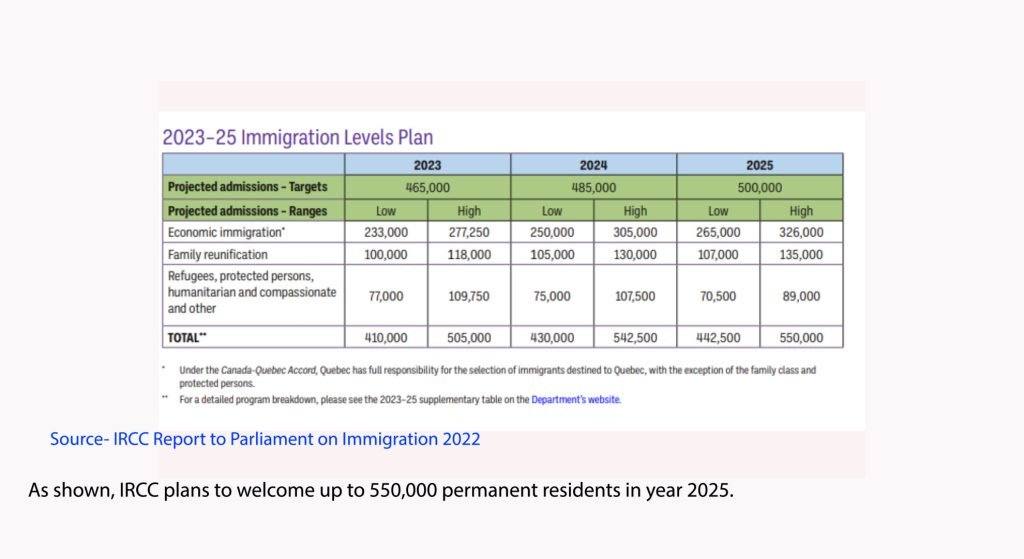Introduction
Immigrating to Canada by becoming a permanent resident of Canada is the ultimate step towards achieving your immigration goals.
Canada is a country that welcomes immigrants from all over the world. To this end, Canada offers over 100 different pathways to immigrate to Canada.
As reported by IRCC to the Canadian Parliament, Canada intends to admit from 505,000 to 550,000 new immigrants by year 2025.

Permanent resident status in Canada is highly sought at it gives immigrants the ability to live in Canada permanently and to become Canadian citizens upon meeting requirements to this end.
Immigration powers in Canada are shared between Canada’s federal and provincial governments.
Similarly to other countries, Canada’s permanent residence programs are geared to making Canada a better place, whether economically, socially, culturally, or with intent of refugee protection or exercising humanitarian action.
Factors to Consider in Selecting a Canada Permanent Residence Program
Deciding on the right Canada permanent residence program is one of the most significant matters for the immigrant, particularly where this also affects his (her) immigrant’s family.

We counsel our clients to consider this decision as soon as possible during their immigration process, particularly when the immigrant chooses to first come to Canada as a temporary resident, such as under a work permit.
Decisions made towards temporary residence process will have an impact on options for a later permanent residence application. In other words, the temporary residence decisions launch an interrelated chain of falling dominos.
Many factors must be considered when deciding on a permanent residency program, such as eligibility requirements, processing times, your age, education, work experience, language proficiency, adaptability, and the part of Canada in which you would like to live in.
Immigration Categories for Canada Permanent Residence
While there exist different categorizations of Canada permanent residence programs, we group them as follows:
- Category 1: Canada Permanent residence through Canada’s federal (national economic) programs such as Express Entry;
- Category 2: Canada Permanent residence through Canada’s federal (regional development) economic programs.
- Category 3: Canada Permanent residence through Canada’s provincial economic programs, namely provincial nominations;
- Category 4: Canada Permanent residence through Canada’s social immigration programs such as family reunification;
- Category 5: Canada Permanent residence through Canada’s refugee and humanitarian programs.
We will consider these categories below.
The Federal Economic Programs (Category 1)
Canada’s national permanent residence economic programs are designed to attract skilled workers who can contribute to the country’s economy. These include the Express Entry Program which houses three (3) programs.
The Express Entry Program
The Express Entry Program is a Canada permanent residence program that targets three groups of of foreign nationals wishing to apply for permanent residence status.
Express Entry does this through three federal economic programs: the Federal Skilled Worker Program, the Federal Skilled Trades Program, and the Canadian Experience Class.
The Federal Skilled Worker Program
The principal eligibility requirements for the Skilled Workers Program within the Express Entry system are:
- Education: Applicants must have completed a post-secondary education, such as a diploma or degree, from a recognized institution. The educational qualification demonstrates the applicant’s ability to contribute to the Canadian economy effectively.

- Work Experience: A minimum of one year of continuous full-time or equivalent part-time work experience in a skilled occupation is required. The work experience should be in a National Occupational Classification (NOC) skill type 0, A, or B, which reflects management, professional, technical, or skilled trade occupations.
- Language Proficiency: Proficiency in English or French is essential for successful integration into Canadian society. Applicants must provide valid language test results from approved agencies, such as the International English Language Testing System (IELTS) or the Canadian English Language Proficiency Index Program (CELPIP), to demonstrate their language skills at a level of CLB-7;
- Proof of Funds: Applicants must demonstrate that they have sufficient funds to support themselves and their accompanying family members during their initial stay in Canada. This requirement ensures that applicants can settle in Canada without relying on social assistance programs.
The Federal Skilled Trades Program
The principal eligibility requirements for the skilled trades program are:

- Work Experience: Applicants must have at least two years of full-time work experience (or an equal amount of part-time work experience) in a skilled trade within the five years before applying. The work experience must be in a skilled trade listed under specified trades groups of the National Occupational Classification (NOC). Provincial certification of the trade skills may be required.
- Language Proficiency: meeting the minimum language level of Canadian Language Benchmark (CLB) 5 for speaking and listening, and CLB 4 for reading and writing through a language test approved by Immigration, Refugees and Citizenship Canada (IRCC);
The Canadian Experience Class Program
The Canadian Experience Class is an excellent option for individuals who have gained valuable work experience in Canada and wish to transition to permanent residence.
The principal eligibility requirements for the CEC program are:
![]()
- Work Experience in Canada: applicants must have acquired at least one year of full-time (or equivalent part-time) skilled work experience in Canada within the past three years. According to the Canadian National Occupational Classification (NOC), skilled work experience means work experienced gained in TEER 0, 1, 2, or 3 job categories. Your work experience can be in 1 or more of these categories.
- Language Proficiency: Applicants must demonstrate proficiency in English or French by providing valid language test results and in this respect meet the minimum language level of:
- Canadian Language Benchmark 7 for TEER 0 or TEER 1 jobs, or
- Canadian Language Benchmark 5 for TEER 2 or TEER 3 jobs
- Education: There are no minimum education requirements for the CEC, but having a Canadian educational credential can provide additional points in the Express Entry system. However, foreign educational credentials are also recognized and can contribute to an applicant’s overall profile.
Qualifying for Express Entry
The first step to qualify under any of the three (3) Express Entry programs is to complete and send an online profile which, if accepted, qualifies you enter the Express Entry pool.
Entry into the pool does not, however, qualify you for Express Entry. It is a pre-qualification step. Being a member of the pool simply means that you may receive a later invitation to apply for permanent residence, but this is not guaranteed.
Entry into the pool is based on a system which attributes qualification points based on factors such as age, education, work experience, language proficiency, and adaptability. Only candidates who achieve a higher than minimum score are entered into the Express Entry Pool.
Language is a major condition to enter the pool because applicants are not be admitted unless they meet applicable language requirements.
Invitations to apply for Canada permanent residence
Every few weeks, Canada issues a round of invitations (called a “draw”) to members of the Express Entry pool who meet a specified minimum Comprehensive Ranking System (CRS) score.
The CRS score is another points-based qualification system. It is different from the points system for entry into the Express Entry Pool, but similar in many respects in that the CRS score is also based on factors such as age, education, work experience, and adaptability. The CRS scores and the targeted groups within Express Entry can vary from draw to draw.
For example, a draw could be created at any time inviting skilled workers who are members of the Express Entry Pool to apply for Canada permanent residence as skilled workers.
Canada will then have a quota or number of invitations to accept, and it will do so by starting with members having the highest qualification scores and moving down from there until the quota is reached.
It follows that the last member accepted within the quota is the individual having the lowest CRS score of all accepted members.
For example, for a skilled workers draw acceptances would typically be between the highest possible CRS score of 800 and the lowest accepted CRS score until meeting quota, such as a lowest CRS score of 550, although this number varies from draw to draw.
Applicants who receive an invitation to apply for permanent residence during the course of a draw have sixty (60) days to submit a complete application with supporting documents such as language test results, educational credentials assessment reports, and police certificates.
Canada permanent residence through the Start-Up Visa
The Start-Up Visa program is a Canadian immigration program of the federal government to attract innovative entrepreneurs to establish their start-up businesses in Canada.
 This program aims to stimulate economic growth, create jobs for Canadians, and foster innovation in various sectors.
This program aims to stimulate economic growth, create jobs for Canadians, and foster innovation in various sectors.
To be eligible for the Start-Up Visa program, applicants must meet several criteria.
Firstly, they need to have a qualifying business idea that is supported by a designated organization in Canada. These organizations include angel investor groups, venture capital funds, and business incubators. The designated organization must be willing to invest a minimum amount in the applicant’s start-up venture.
Moreover, applicants must demonstrate proficiency in either English or French language skills at a specified level. They should also possess sufficient funds to settle in Canada and support themselves and their dependents.
Once the eligibility requirements are met, applicants can apply for the Start-Up Visa program.
The application process involves submitting a detailed business plan, securing a letter of support from the designated organization, and undergoing a thorough background and security check.
Upon approval, successful applicants are granted a temporary work permit and can relocate to Canada to launch their start-up venture. They are also eligible to bring their accompanying family members to Canada.
After establishing their business and meeting the program’s performance criteria, participants can apply for Canadian permanent residence. The performance criteria usually include creating jobs for Canadians, receiving additional funding from designated organizations, or generating significant revenue.
The Start-Up Visa program offers a unique opportunity for foreign entrepreneurs to not only grow their innovative businesses but also become Canadian permanent residents. It provides access to Canada’s vibrant start-up ecosystem, diverse talent pool, and robust support systems.
Canada permanent residence for self-employed
As a self-employed person, you can apply for permanent residency in Canada through the Self-Employed Persons Program.
This program is also a points-based system, this time designed for individuals with relevant experience in cultural activities or athletics, and who have the intention and ability to contribute significantly to these fields in Canada.
 To be eligible for the Self-Employed Persons Program, applicants must have a minimum of two years of relevant self-employment experience. This experience should be at a professional level and demonstrate that the applicant has been actively involved in cultural activities, athletics, or a combination of both.
To be eligible for the Self-Employed Persons Program, applicants must have a minimum of two years of relevant self-employment experience. This experience should be at a professional level and demonstrate that the applicant has been actively involved in cultural activities, athletics, or a combination of both.
In addition to this experience requirement, applicants must also meet the selection criteria, which are based on factors such as education, experience, age, language proficiency, and adaptability.
These criteria are assessed using a points system, and applicants must achieve the minimum required score of 35 points out of 100 to be considered eligible.
Canada permanent residence through the Agri-Food Pilot Program
The Agri-Food Pilot program is a Canadian immigration program that addresses Canadian labor needs in the agri-food sector and provides a pathway to permanent residence for eligible foreign workers.
 This program focuses on attracting and retaining experienced workers in specific occupations within the agricultural and agri-food industry.
This program focuses on attracting and retaining experienced workers in specific occupations within the agricultural and agri-food industry.
The Agri-Food Pilot program is employer-driven, meaning that applicants must have a valid job offer from a Canadian employer in one of the eligible occupations.
These occupations span various sectors such as farming, meat processing, greenhouse crop production, and livestock raising.
To be eligible for the Agri-Food Pilot program, applicants must meet certain requirements. This includes having at least one year of full-time work experience in an eligible occupation in Canada.
They must also meet the minimum language proficiency requirements in English or French, demonstrate sufficient settlement funds, and have a genuine intention to work and live in the participating province.
Successful applicants under the Agri-Food Pilot program are granted a temporary work permit, which allows them to work for their designated employer in the agri-food sector.
After fulfilling program requirements, such as meeting the work experience criteria and fulfilling the terms of their job offer, they can apply for permanent residence through a dedicated pathway within the program.
Canada’s regional development immigration programs (Category 2)
While Canada has a large land mass, its population is concentrated in major cities and regions close to the U.S. border.
The vast expanse of Canada has meant that Canada’s regions and outlying smaller population centers have mostly suffered economically over Canada’s history.
Atlantic Canada whose economy was greatly dependent on fishing was gravely harmed by over-fishing in its waters by foreign fishing groups. This has forced Atlantic Canada to find new sources of income.
Canada’s Northern and Rural areas have similarly faced economic difficulties due to economic and social forces.
It follows that Canada’s regional development has been a longstanding source of concern for Canada’s governments.
In response to these realities, Canada has added immigration programs designed to encourage economic growth in these areas.
Federally, Canada has instituted 2 programs, namely the Atlantic Immigration Pilot Program (AIPP) and the Rural and Northern Economic Pilot.
Canada Permanent Residence with the Atlantic Immigration Program (AIP)
The Atlantic Immigration Program is a pathway to permanent residence for skilled foreign workers, as well as international graduates from a Canadian institution, who agree to work and live in one of Canada’s four Atlantic provinces: New Brunswick, Nova Scotia, Prince Edward Island, or Newfoundland and Labrador.
The Atlantic Immigration Program is an employer-driven program that facilitates the hiring of foreign nationals.
 Employers can participate in the program by becoming designated in one of the Atlantic provinces. Candidates can apply by meeting the program requirements and getting a job offer that meets the program criteria.
Employers can participate in the program by becoming designated in one of the Atlantic provinces. Candidates can apply by meeting the program requirements and getting a job offer that meets the program criteria.
To qualify under the program, an applicant must either be a recent graduate of a qualifying university in Atlantic Canada or have qualifying work experience inside or outside Canada.
While their permanent application is being processed, foreign nationals can apply for and hold a temporary work permit with a designated employer in Atlantic Canada.
Canada Permanent Residence with the Rural and Northern Immigration Pilot (RNIP)
The Rural and Northern Immigration Pilot (RNIP) is a community-driven program designed to attract skilled workers to smaller communities in Canada.
 The program is currently available in eleven (11) participating communities across Canada. Each community has its own specific requirements, including language requirements.
The program is currently available in eleven (11) participating communities across Canada. Each community has its own specific requirements, including language requirements.
To be eligible for the RNIP, applicants must have a job offer from an employer in one of the participating communities, meet the minimum language requirements for their occupation and job offer, satisfy the education and work experience requirements for their occupation and job offer, and intend to live in the community where they apply.
Applicants should check the specific requirements of the community they are interested in before applying. The detailed steps to permanent residence of each program also vary depending on the community.
Canada’s Provincial Economic Immigration Programs (Category 3)
A key decision to be made by a foreign national seeking permanent residence in Canada through one of its economic programs is whether to pursue this directly under a federal program such as federal Express Entry, the Atlantic Immigration Pilot, the Rural and Northern Immigration Pilot, or alternatively to choose a provincial route through one of the many provincial nomination programs.
There are similarities, but also differences, between the federal and provincial programs, as well as between provinces.
Foreign nationals may elect to choose one of the provincial nomination programs instead of a federal national economic programs for several reasons.
 Firstly, the eligibility conditions for provincial nominee programs are different from those of federal programs. Provincial nominee programs are designed by the provinces to help meet their unique immigration goals, so their eligibility criteria and application procedures vary.
Firstly, the eligibility conditions for provincial nominee programs are different from those of federal programs. Provincial nominee programs are designed by the provinces to help meet their unique immigration goals, so their eligibility criteria and application procedures vary.
Secondly, provincial nominee programs could offer an easier pathway to permanent residence to many individuals. Every year, the Canadian federal government increases the number of invitations for PNP candidates. These programs are the fastest-growing route to economic immigration in Canada.
Intending immigrants under a PNP should have the necessary skills, proper education, sufficient work experience, and a passing language examination result for semi or low-skilled trades in line with provincial language requirements for the specific program they are applying under.
One factor often weighing considerably in the choice of a program turns on provincial language requirements, which can be lower than the federal standards, depending on the province and the program.
Provincial nominee programs are related to the federal Express Entry Program in that provincial nominee programs are aligned with the Express Entry system.
This means that candidates who are nominated by a province or territory under an Express Entry-aligned provincial stream receive additional points under the Comprehensive Ranking System (CRS) and are invited to apply for permanent residence through regular draws from the Express Entry pool.
The CRS points (600) resulting from a provincial nomination are substantial and usually sufficient in themselves to meet CRS qualification scores.
One step versus two steps
Provinces are not empowered under Canada’s Constitution to grant permanent residence.
Instead, by virtue of federal-provincial agreements, provinces are entitled to “nominate” (generally meaning recommend) immigrants to the federal government for Canadian permanent residence. Thus, going under the provincial route creates a 2-step process first a provincial nomination, second a federal PR approval.
Although there is no universally preferable route, it may at times be the better option for a foreign national to seek a provincial nomination.
One instance where this can be beneficial is where one needs the provincial nomination points (600) under the federal Express Entry program to gain sufficient CRS points in one of the draws.
But as the provincial route adds another layer of bureaucracy, one of our jobs as immigration lawyers is to evaluate whether a one-step approach (direct application to the federal government) versus a two-step approach is preferable. Again, a provincial nomination under a provincial program requires a subsequent application for permanent residence federally under Express Entry.
This decision will turn mostly on the personal profile of each immigrant, after considering strengths, weaknesses, and chances of a direct approval by the federal government under Express Entry.
We always advise clients seeking temporary residence in Canada through a work permit to consider immediately in what province he or she would want to live as a permanent resident of Canada since it is preferable to align the province of work under a work permit with the province of permanent residence to avoid personal and family disruptions.
Canada Permanent Residence with The Provincial Nomination Programs
When we speak of a provincial nomination route (PNP), we are referring to eleven (11) provinces and territories each having one or several immigration nomination programs.
This includes all nine out of ten Canadian provinces (not Quebec) plus the Northwest Territories and Yukon.
Quebec is not included in this list as it has its own programs which are similar in many respects, but operating differently since Quebec has the enhanced power of selecting its own immigrants. We will address Quebec below.
The Canadian Nunavut territory is also not included as it does not presently have a nomination program.
Canada Permanent Residence With the Quebec Skilled Workers Program
Quebec has adopted its own Skilled Workers Program This program is designed to select immigrants who Quebec considers are likely to become economically established in Quebec.
 Applicants are assessed based on factors such as education, work experience, language proficiency, age, and other factors that indicate their ability to integrate into Quebec society.
Applicants are assessed based on factors such as education, work experience, language proficiency, age, and other factors that indicate their ability to integrate into Quebec society.
One of the key differences between the Quebec Skilled Workers Program and other provincial nominee programs is that applicants must demonstrate proficiency in French. This is because French is the official language of Quebec.
Regarding the application process, the key difference with other provinces is that applicants must obtain a “Certificat de sélection du Québec (CSQ)” (a Quebec Selection Certificate) before they can apply for permanent residence to the federal government. It is therefore not a provincial “nomination” process.
The CSQ is issued by the Government of Quebec and indicates that the applicant has been selected for immigration to Quebec.
Despite Quebec’s French language requirements, Quebec should still be considered by individuals not having French language skills.
Quebec offers substantial assistance towards learning the minimum French skills over the number of years leading to permanent residence.
In addition, Quebec offers many advantages as a place to live (such as lower costs of housing) and should thus receive serious consideration. We can provide information in this regard.
Canada’s Social Immigration Programs (Category 4)

While economic immigration programs are a primary focus of Canada, its immigration policies also provide room for social imperatives. Family unification and caregiver programs form part of Canada’s social program offers.
Family Sponsorship
Family sponsorship is a program that allows Canadian citizens and permanent residents to sponsor their family members to come and live in Canada.
The program is designed to reunite families and thus keep them together. The family members that can be sponsored include spouses, common-law partners, dependent children, parents, and grandparents.
To be eligible for family sponsorship, the sponsor must meet certain requirements such as being at least 18 years old, being a Canadian citizen or permanent resident, and demonstrating the ability to support the sponsored family member financially.
Caregiver Programs
The caregiver program is designed for individuals who have experience working as a caregiver for children, elderly persons, or people with disabilities.
 The program allows caregivers to come to Canada and work for a Canadian employer. After working in Canada for two years, caregivers can apply for permanent residence.
The program allows caregivers to come to Canada and work for a Canadian employer. After working in Canada for two years, caregivers can apply for permanent residence.
To be eligible for the caregiver program, applicants must have a job offer from a Canadian employer and meet certain language and education requirements. They must also undergo a medical exam and obtain a police certificate.
Canada’s Refugee and Humanitarian Immigration Programs (Category 5)
Canada has a long-standing tradition of welcoming refugees and providing them with a haven. Canada has several programs that allow refugees and other individuals in need of humanitarian protection to apply for permanent residency.
Refugee Protection in Canada
 Canada’s refugee protection program is designed to provide protection to individuals who are outside their home country and are unable or unwilling to return due to a well-founded fear of persecution based on race, religion, nationality, political opinion, or membership in a particular social group.
Canada’s refugee protection program is designed to provide protection to individuals who are outside their home country and are unable or unwilling to return due to a well-founded fear of persecution based on race, religion, nationality, political opinion, or membership in a particular social group.
The program is administered by Immigration, Refugees and Citizenship Canada (IRCC) and includes several streams, such as the Government-Assisted Refugee Program and the Private Sponsorship of Refugees Program.
The asylum process can be complex and challenging, but there are several tips that can help applicants increase their chances of success.
These include gathering all required documents, providing proof of funds to support themselves and their families, taking language proficiency tests to demonstrate their ability to communicate in English or French, undergoing criminal and medical checks, and seeking professional assistance from an immigration specialist.
Ukraine

The war crisis in Ukraine has prompted the Canadian federal government to assist Ukrainians in leaving Ukraine and to offer them an open work permit of a duration of 3 years for a period of temporary residence.
Ukrainians in Canada can also apply for permanent residence based on one of the available programs.
Hong Kong
 Due to political turmoil in Hong Kong, Canada has offered qualifying Hong Kong residents a 3-year open work permit.
Due to political turmoil in Hong Kong, Canada has offered qualifying Hong Kong residents a 3-year open work permit.
This can be followed by a permanent residence application under 2 streams, namely for in-Canada graduates and workers have Canadian work experience.
Tips and Advice for a successful Canada permanent residence application
Gather Required Documents
Each provincial immigration program has its set of requirements and documentation that applicants must provide.
It is important to carefully review the requirements for the program you are interested in and gather all required documents before submitting your application.
Proof of Funds
Applicants must also provide proof of funds to support themselves and their families while they settle in Canada.
The amount of funds required varies depending on the size of the family and the province or territory. You must plan your permanent residence application to ensure that you have these funds on hand.
Language Proficiency Tests
Language proficiency tests are often required as part of the application process for provincial immigration programs. Applicants must demonstrate their ability to communicate effectively in English or French.
It follows that applicants should verify as quickly as possible the language requirements of the program which they which to apply under, and ensure that they meet these language requirements.
Upon your request, we can send you a link to a non-official language test. While this test has no official value, it may give you a preliminary indication of where you stand.
Should you not be meeting language requirements in all 4 disciplines (reading, writing, listening, and speaking), you should plan to enroll in language courses either inside or outside Canada before commencing your process of applying for permanent residence. We can provide advice on language courses.
Criminal and Medical Checks
Most applicants for permanent residency in Canada must undergo criminal and medical checks to ensure they do not pose a risk to Canadian society and are not likely to place excessive demands on Canada’s healthcare system.
Conclusion
This Guide should answer most of your questions. We are however at your disposition should you wish to make sure you’re making the right decisions for yourself and your family through this complex web of information and programs.
